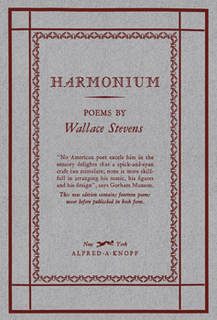Related Research Articles

Wallace Stevens was an American modernist poet. He was born in Reading, Pennsylvania, educated at Harvard and then New York Law School, and he spent most of his life working as an executive for an insurance company in Hartford, Connecticut. He won the Pulitzer Prize for Poetry for his Collected Poems in 1955.

Harmonium is a book of poetry by American poet Wallace Stevens. His first book at the age of forty-four, it was published in 1923 by Knopf in an edition of 1500 copies. This collection comprises 85 poems, ranging in length from just a few lines to several hundred. Harmonium was reissued in 1931 with three poems omitted and fourteen new poems added.
"Domination of Black" is a poem in Wallace Stevens' Harmonium, first published in 1916 and later (1942) selected by him as his best poem for the anthology This Is My Best.
"Nuances of a Theme by Williams" is a poem from Wallace Stevens's first book of poetry, Harmonium.
"Fabliau of Florida" is a poem in Wallace Stevens's first book of poetry, Harmonium.
"From the Misery of Don Joost" is a poem from Wallace Stevens's first book of poetry, Harmonium. It is in the public domain, having been published in the journal Poetry in 1921.
"O Florida, Venereal Soil" is a poem from Wallace Stevens's first book of poetry, Harmonium. It was first published in the journal Dial, volume 73, July 1922, and is therefore in the public domain.
"Last Looks at the Lilacs" is a poem from Wallace Stevens's first book of poetry, Harmonium. It was first published in 1923.
"Floral Decorations for Bananas" is a poem from Wallace Stevens's first book of poetry, Harmonium (1923). It was first published Measure 26 and is therefore under copyright, however it is quoted here as justified by fair use in order to facilitate scholarly commentary.
"The Curtains in the House of the Metaphysician" is a poem from Wallace Stevens's first book of poetry, Harmonium. It was originally published in 1919, so it is in the public domain.
"Banal Sojourn" is a poem from Wallace Stevens's first book of poetry, Harmonium. It was originally published in 1919, therefore it is in the public domain.
"Depression Before Spring" is a poem from Wallace Stevens's first book of poetry, Harmonium (1923). It was first published in 1918 and is therefore in the public domain.
"Stars at Tallapoosa" is a poem from Wallace Stevens's first book of poetry, Harmonium. It was first published in 1922, so it is in the public domain.
"Bantams in Pine-Woods" is a poem from Wallace Stevens's first book of poetry, Harmonium. It was first published in 1922 in the poetry journal Dial, along with five other poems, all under the title "Revue". It is in the public domain.
"Thirteen Ways of Looking at a Blackbird" is a poem from Wallace Stevens's first book of poetry, Harmonium. The poem consists of thirteen short, separate sections, each of which mentions blackbirds in some way. Although inspired by haiku, none of the sections meets the traditional definition of haiku. It was first published in October 1917 by Alfred Kreymborg in Others: An Anthology of the New Verse and two months later in the December issue of Others: A Magazine of the New Verse.
"The Death of a Soldier" is a poem from Wallace Stevens's first book of poetry, Harmonium. The poem uses free verse to describe the death of a soldier.
"Tea" is a poem from Wallace Stevens' first book of poetry, Harmonium. It was first published in 1915 in the journal Rogue, so it is in the public domain.
"The Public Square" is a poem from the second edition (1931) of Wallace Stevens's first book of poetry, Harmonium. It was first published in 1923, so it is one of the few poems in the collection that is not free of copyright, but it is quoted here in full as justified by fair use for scholarly commentary.
The indigenous peoples of Florida lived in what is now known as Florida for more than 12,000 years before the time of first contact with Europeans. However, the indigenous Floridians have largely died out with some completely by the early 18th century. Some Apalachees migrated to Louisiana, where their descendants now live, some were taken to Cuba and Mexico by the Spanish in the 18th century, and a few may have been absorbed into the Seminole and Miccosukee tribes.

The Auroras of Autumn is a 1950 book of poetry by Wallace Stevens. The book of poems contains the long poem of 10 cantos by Stevens of the same name.
References
- Cook, Eleanor. A Reader's Guide to Wallace Stevens. Princeton: Princeton University Press.
- Stevens, H. Letters of Wallace Stevens. 1966: University of California Press
| This article related to a poem is a stub. You can help Wikipedia by expanding it. |